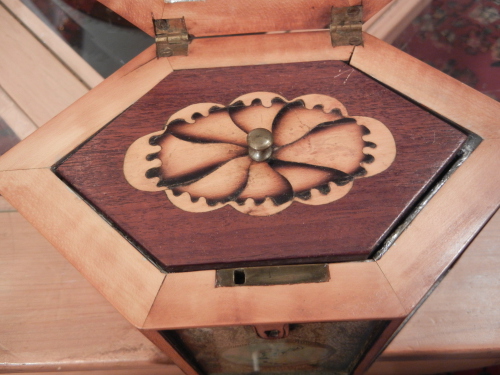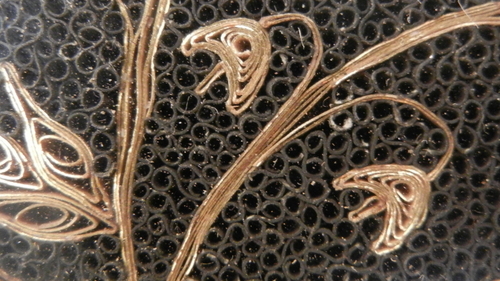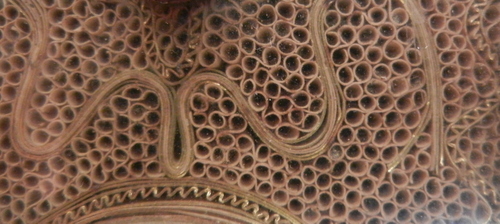
|
|
|
|
| REGISTER (click here) |
How to Post Photos
|

|
 SMP Silver Salon Forums SMP Silver Salon Forums
  Flatware/Holloware - non silver Forum Flatware/Holloware - non silver Forum
  Rolled paper tea caddy Rolled paper tea caddy
|
| next newest topic | next oldest topic |
| Author | Topic: Rolled paper tea caddy |
|
ahwt Posts: 2334 |
  
[28-0032] My wife collects tea caddies and above is one tea caddy made with rolled paper. These tea caddies were popular in the last decade of the 1700s and even Jane Austen in her book Sense and Sensibility refers to the making of rolled paper baskets. As I understand, the boxes were brought already made and women of that time period would decorate these boxes with various designs made from rolled paper and other materials. This is the only one that my wife has that has glass over the decorations. As a result the interior design does not seem to have aged and the golden stripes shine brightly as if new. My question is what were these “golden stripes” made of. Some of the rolled paper appears to be gilded, but some of the other decoration appears to be simply gold wire. Any thoughts you have would be appreciated. IP: Logged |
|
ahwt Posts: 2334 |
  
 Above is a picture of the inside lid and it is really just like many other wooden tea caddies as it is not decorated with rolled paper. IP: Logged |
|
Scott Martin Forum Master Posts: 11520 |
  
I've never seen one before. It looks like filigree. A close up of the filigree looking paper work would be interesting. IP: Logged |
|
Scott Martin Forum Master Posts: 11520 |
  
I went looking....
quote: IP: Logged |
|
ahwt Posts: 2334 |
  
  Here are a couple of pictures that show a little more detail. Some of the rolled paper appears to be gilded and the long strips most likely are also just gilded rather that solid gold wires. Below I added some pictures of another tea caddy, almost the same shape, but without glass covering the paper. There is gilding on parts of the box, but the background decoration appears to be mica. The rolled paper is darker perhaps since it was not covered with glass. IP: Logged |
|
ahwt Posts: 2334 |
  
This last tea caddy has gilding on the wooden portions and the remainder of the decoration is both rolled paper and the paper forming the bird or date. I don’t think any of the paper started out with gilding, but this one is interesting as it does have a date included. There is also a little repair work on the back of the box that tries to mimic rolled paper. IP: Logged |
|
Polly Posts: 1970 |
  
I just attended a talk (about Emily Bronte's manuscripts) by a Victorianist friend, who showed a slide of a quilled paper tea caddy that Charlotte Bronte made for her BFF, Ellen Nussey. Oh, wait--here it is: quote: IP: Logged |
|
ahwt Posts: 2334 |
  
Polly, Thanks for the link to an interesting part of Emily Bronte's life. That website is a real trove of interesting relics. Sometimes the past can give up its secrets. [This message has been edited by ahwt (edited 09-20-2015).] IP: Logged |
|
Polly Posts: 1970 |
  
ahwt, if you like that website (my friend's tumblr blog), I bet you would enjoy her new book, The Bronte Cabinet: Three Lives in Nine Objects. She explores the lives of the Bronte sisters through objects such as Emily's dog's collar, Charlotte's sewing box, and the tiny books the siblings wrote as children (including "The Silver Cup: A Tale"). I recommend it enthusiastically. [This message has been edited by Polly (edited 09-20-2015).] IP: Logged |
|
ahwt Posts: 2334 |
  
Thanks Polly for the recommendation. I will order it. In a different vein I recently bought; "Dining with the Washingtons: Historic Recipes, Entertainment, and Hospitality from Mount Vernon" Mostly factual kinds of things without much interpretation, but it does have pictures and descriptions of some of the silver George had and used. I had always thought that he brought most of his silver from England, but this book shows some interesting silver from New York and Philadelphia. Art [This message has been edited by ahwt (edited 09-20-2015).] IP: Logged |
|
ellabee Posts: 306 |
  
IP: Logged |
All times are ET | next newest topic | next oldest topic |
  |
|
Ultimate Bulletin Board 5.46a
|
1. Public Silver Forums (open Free membership) - anyone with a valid e-mail address may register. Once you have received your Silver Salon Forum password, and then if you abide by the Silver Salon Forum Guidelines, you may start a thread or post a reply in the New Members' Forum. New Members who show a continued willingness to participate, to completely read and abide by the Guidelines will be allowed to post to the Member Public Forums. 2. Private Silver Salon Forums (invitational or $ donation membership) - The Private Silver Salon Forums require registration and special authorization to view, search, start a thread or to post a reply. Special authorization can be obtained in one of several ways: by Invitation; Annual $ Donation; or via Special Limited Membership. For more details click here (under development). 3. Administrative/Special Private Forums (special membership required) - These forums are reserved for special subjects or administrative discussion. These forums are not open to the public and require special authorization to view or post. |
|
copyright © 1993 - 2022
SM Publications
All Rights Reserved. Legal & Privacy Notices |